
Pomeranian Voivodeship is a voivodeship, or province, in northwestern Poland. The provincial capital is Gdańsk.

Starogard County is a unit of territorial administration and local government (powiat) in Pomeranian Voivodeship, northern Poland. The name is a combination of two terms: stari which is Slavic for old and gard which is Pomeranian language stands for town, city, fortified settlement. In this meaning, the term gard is still being used in the only surviving dialect of the Pomeranian, Kashubian language. The county came into being on January 1, 1999, as a result of the Polish local government reforms passed in 1998. Its administrative seat and largest town is Starogard Gdański, which lies 45 kilometres (28 mi) south of the regional capital Gdańsk. The county contains three other towns: Skarszewy, 13 km (8 mi) north-west of Starogard Gdański, Skórcz, 19 km (12 mi) south of Starogard Gdański, and Czarna Woda, 33 km (21 mi) south-west of Starogard Gdański. Starogard County is part of the area traditionally inhabited by the Kociewiacy ethnic group.
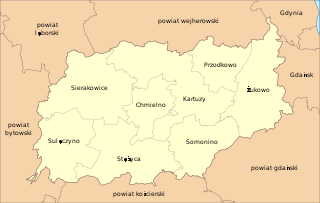
Kartuzy County is a county in the Pomeranian Voivodeship, Poland, with administrative seat and largest town being Kartuzy.

Puck County is a unit of territorial administration and local government (powiat) in Pomeranian Voivodeship, northern Poland, on the Baltic coast. The powiat of this name existed in the history of Poland, since the times of the Polish–Lithuanian Commonwealth up to 1795, and then reintroduced in 1999.

Kościerzyna County is a unit of territorial administration and local government (powiat) in Pomeranian Voivodeship, northern Poland. It came into being on 1 January 1999 as a result of the Polish local government reforms passed in 1998. Its administrative seat and only town is Kościerzyna, which lies 51 kilometres (32 mi) south-west of the regional capital Gdańsk. Its borders equal approximately the borders of the old Marquessate of Berent in the German Empire.
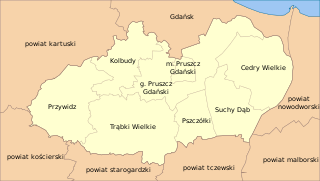
Gdańsk County is a unit of territorial administration and local government (powiat) in Pomeranian Voivodeship, northern Poland. It came into being on January 1, 1999, as a result of the Polish local government reforms passed in 1998. It includes areas to the east and south of the city of Gdańsk, from which the county takes its name, although the city is not part of its territory. The county seat and only town in Gdańsk County is Pruszcz Gdański, which lies 12 kilometres (7 mi) south of central Gdańsk.

Człuchów County is a unit of territorial administration and local government (powiat) in Pomeranian Voivodeship, northern Poland. It came into being on January 1, 1999, as a result of the Polish local government reforms passed in 1998. Its administrative seat and largest town is Człuchów, which lies 115 kilometres (71 mi) south-west of the regional capital Gdańsk. The county also contains the towns of Czarne, lying 28 km (17 mi) west of Człuchów, and Debrzno, 16 km (10 mi) south-west of Człuchów.

Kwidzyn County is a unit of territorial administration and local government (powiat) in Pomeranian Voivodeship, northern Poland. It came into being on January 1, 1999, as a result of the Polish local government reforms passed in 1998. Its administrative seat and largest town is Kwidzyn, which lies 73 kilometres (45 mi) south of the regional capital Gdańsk. The only other town in the county is Prabuty, lying 18 km (11 mi) east of Kwidzyn.
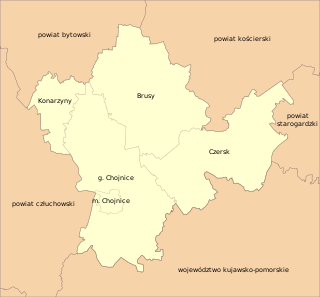
Chojnice County is a unit of territorial administration and local government (powiat) in Pomeranian Voivodeship, northern Poland. It came into being on January 1, 1999, as a result of the Polish local government reforms in 1998. Its administrative seat and largest town is Chojnice, which lies 103 kilometres (64 mi) south-west of the regional capital Gdańsk. The county also contains the towns of Czersk, lying 30 km (19 mi) east of Chojnice, and Brusy, 24 km (15 mi) north-east of Chojnice.

Lębork County is a unit of territorial administration and local government (powiat) in Pomeranian Voivodeship, northern Poland, on the Baltic coast. It came into being on January 1, 1999, as a result of the Polish local government reforms passed in 1998. Its administrative seat and largest town is Lębork, which lies 61 kilometres (38 mi) west of the regional capital Gdańsk. The only other town in the county is Łeba, lying 29 km (18 mi) north-west of Lębork.

Nowy Dwór Gdański County is a unit of territorial administration and local government (powiat) in Pomeranian Voivodeship, northern Poland, on the Baltic coast. It came into being on 1 January 1999 as a result of the Polish local government reforms passed in 1998. Its administrative seat and largest town is Nowy Dwór Gdański, which lies 36 kilometres (22 mi) south-east of the regional capital Gdańsk. The only other town in the county is Krynica Morska, lying 29 km (18 mi) north-east of Nowy Dwór Gdański, on the Vistula Spit.
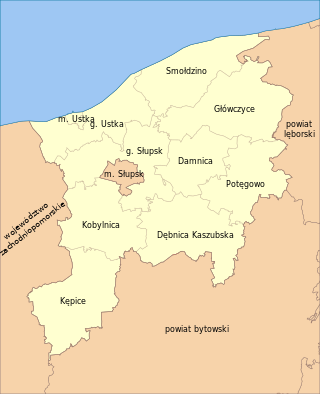
Słupsk County is a unit of territorial administration and local government (powiat) in Pomeranian Voivodeship, northern Poland, on the Baltic coast. It came into being on 1 January 1999, as a result of the Polish local government reforms passed in 1998. Its administrative seat is the city of Słupsk, although the city is not part of the county. The only towns in Słupsk County are Ustka, a coastal resort 18 km (11 mi) north-west of Słupsk, and Kępice, 27 km (17 mi) south of Słupsk.

Sztum County is a unit of territorial administration and local government (powiat) in Pomeranian Voivodeship, northern Poland. Its administrative seat and largest town is Sztum, which lies 56 kilometres (35 mi) south-east of the regional capital Gdańsk. The only other town in the county is Dzierzgoń, lying 21 km (13 mi) east of Sztum.
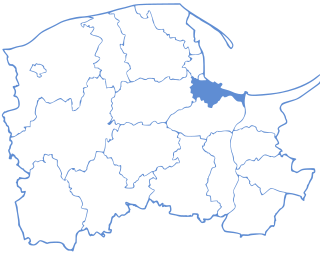
Tczew County is a unit of territorial administration and local government (powiat) in Pomeranian Voivodeship, northern Poland. It came into being on January 1, 1999, as a result of the Polish local government reforms passed in 1998. Its administrative seat and largest town is Tczew, which lies 31 kilometres (19 mi) south of the regional capital Gdańsk. The county also contains the towns of Pelplin, lying 20 km (12 mi) south of Tczew, and Gniew, 31 km (19 mi) south of Tczew. The county is part of the area traditionally inhabited by the Kociewiacy ethnic group.

Bytów County is a unit of territorial administration and local government (powiat) in Pomeranian Voivodeship, northern Poland. It came into being on January 1, 1999, as a result of the Polish local government reforms passed in 1998. Its administrative seat and largest town is Bytów, which lies 79 kilometres (49 mi) west of the regional capital Gdańsk. The only other town in the county is Miastko, lying 37 km (23 mi) west of Bytów.
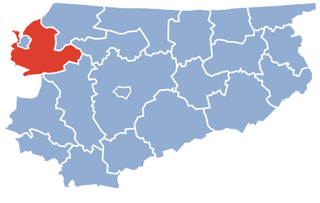
Elbląg County is a unit of territorial administration and local government (powiat) in Warmian-Masurian Voivodeship, northern Poland. It came into being on January 1, 1999, as a result of the Polish local government reforms passed in 1998. Its administrative seat is the city of Elbląg, although the city is not part of the county. The county contains three towns: Pasłęk, 18 km (11 mi) east of Elbląg, Tolkmicko, 27 km (17 mi) north of Elbląg, and Młynary, 24 km (15 mi) north-east of Elbląg.
Gmina Nowy Staw is an urban-rural gmina in Malbork County, Pomeranian Voivodeship, in northern Poland. Its seat is the town of Nowy Staw, which lies approximately 12 kilometres (7 mi) north of Malbork and 36 km (22 mi) south-east of the regional capital Gdańsk.
Gmina Nowy Dwór Gdański is an urban-rural gmina in Nowy Dwór Gdański County, Pomeranian Voivodeship, in northern Poland. Its seat is the town of Nowy Dwór Gdański, which lies approximately 36 kilometres (22 mi) south-east of the regional capital Gdańsk.
Gmina Pelplin is an urban-rural gmina in Tczew County, Pomeranian Voivodeship, in northern Poland. Its seat is the town of Pelplin, which lies approximately 20 kilometres (12 mi) south of Tczew and 50 km (31 mi) south of the regional capital Gdańsk.

Wejherowo County is a unit of territorial administration and local government (powiat) in Pomeranian Voivodeship, northern Poland, on the Baltic coast. It came into being on January 1, 1999, as a result of the Polish local government reforms passed in 1998. Its administrative seat and largest town is Wejherowo, which lies 36 kilometres (22 mi) north-west of the regional capital Gdańsk. The county also contains the towns of Rumia, lying 11 km (7 mi) east of Wejherowo, and Reda, 7 km (4 mi) east of Wejherowo. Rumia, Reda and Wejherowo are contiguous, and are referred to as the Kashubian Tricity, an allusion to the larger Tricity area centred on Gdańsk.






















